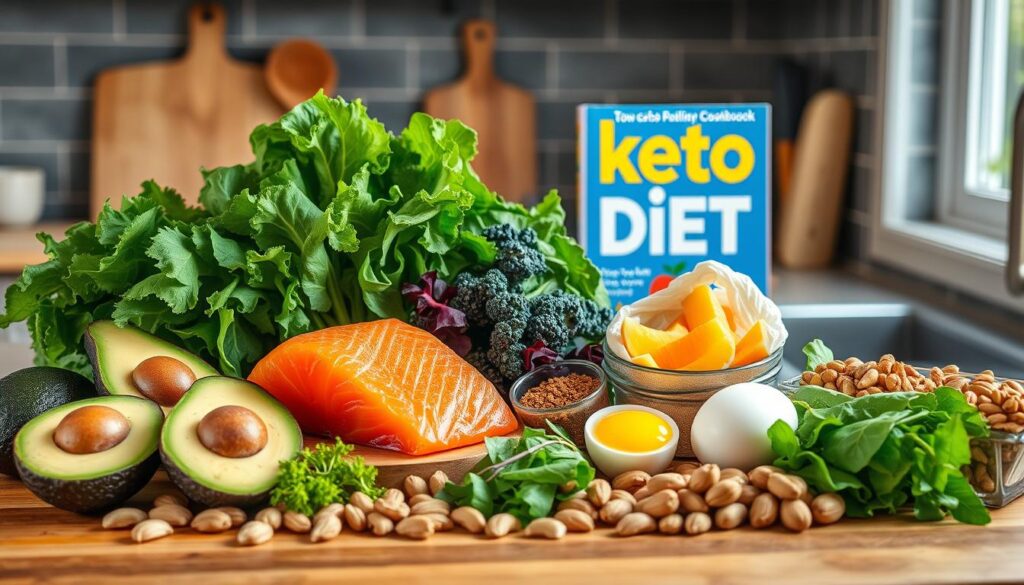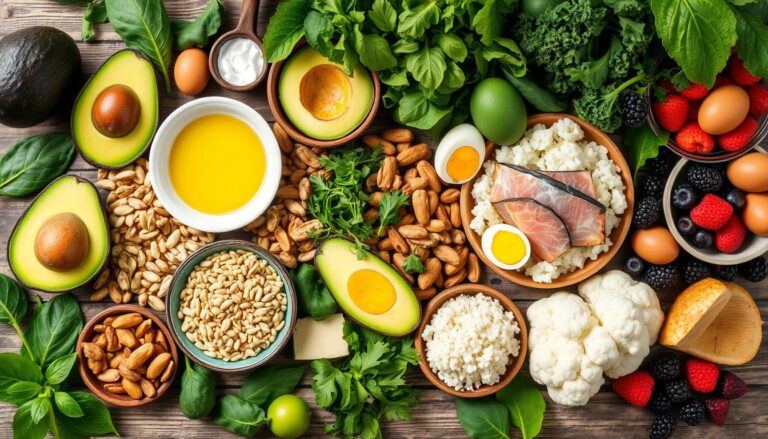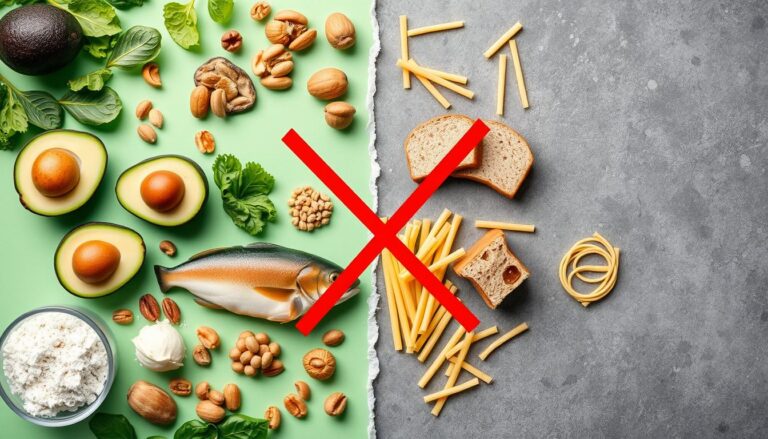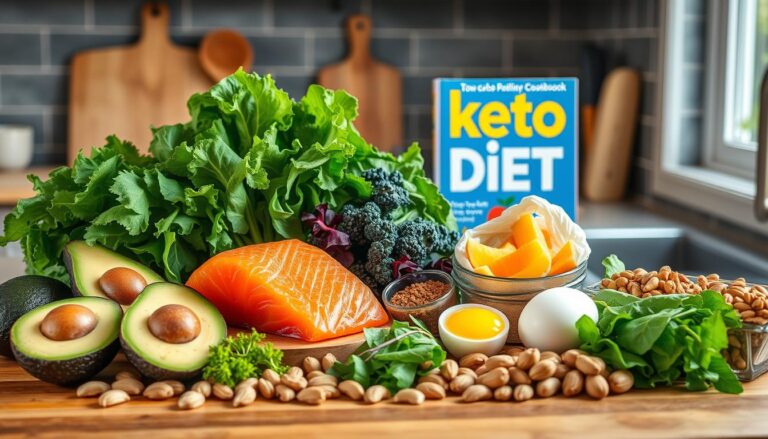I’m excited to share my knowledge about the keto diet for beginners. This guide will give you a full understanding of what is keto and how it works. The keto diet has become popular for its health benefits, and I’m here to help you start your keto journey.
The keto diet for beginners might seem complex, but it’s actually simple and effective. Knowing what is keto and how it works helps you make better diet choices. It’s a low-carb lifestyle that can lead to weight loss and better blood sugar control.
Exploring the keto world, I’ve learned about its benefits and challenges. From keto basics to handling social situations, I aim to share my insights with you. Whether you want to lose weight or boost your health, starting with the keto diet is a smart choice.
Introduction to the Keto Lifestyle
In this guide, we’ll dive into the keto diet’s details. We’ll cover what is keto and its benefits and challenges. Plus, we’ll offer tips and advice for beginners.
Key Takeaways
- Understanding the basics of the keto diet is essential for success
- The keto diet is a low-carb lifestyle that can be beneficial for weight loss and overall health
- What is keto and how it works is crucial for making informed decisions about your diet
- The keto diet for beginners can seem overwhelming, but it’s actually a simple and effective way to improve your health
- Staying committed to the keto lifestyle is key to achieving your health and wellbeing goals
Understanding the Keto Diet for Beginners
Starting a keto diet for beginners might seem hard. But, knowing the basics makes it easier.
What Is the Ketogenic Diet?
The ketogenic diet is a plan that focuses on eating less carbs and more fats. It helps your body use fat for energy instead of carbs.
The Science Behind Ketosis
Ketosis explained means your liver turns fats into ketones. These ketones are your main energy source. This change brings many benefits:
- Enhanced fat burning
- Improved mental clarity
- Stable energy levels
Key Principles of Keto Living
To live a ketogenic lifestyle, you need to:
- Eat high-quality fats
- Have moderate protein
- Keep carbs very low

Following these rules helps keep you in ketosis and makes the diet work better.
| Principle | Description |
|---|---|
| Low Carbs | Limit carb intake to 20-50 grams per day. |
| High Fat | Get 70-75% of your calories from fats. |
| Moderate Protein | Protein should be about 20% of your diet. |
The Fundamentals of Ketosis
Understanding ketosis explained is key when starting a low-carb diet. At first, I learned my body had to switch from using glucose to fat.
This change happens when insulin levels go down. This lets stored fat turn into fatty acids and ketones. Then, ketones become the main energy for the brain and muscles, a process called fat adaptation.

- Reduced glucose availability
- Increased fat burning
- Ketone production for energy
Insulin is important for controlling blood sugar. Lower insulin levels help break down fat, making ketosis explained easier to understand for those on a low-carb diet.
| Metabolic Change | Description |
|---|---|
| Glucose Utilization | Decreases as fat becomes the primary energy source |
| Insulin Levels | Reduce, promoting fat breakdown |
| Ketone Production | Increases to supply energy to the brain and muscles |
Essential Foods on the Ketogenic Diet
Starting a ketogenic lifestyle means picking the right foods. Knowing how to start keto makes the journey easier and more fun.
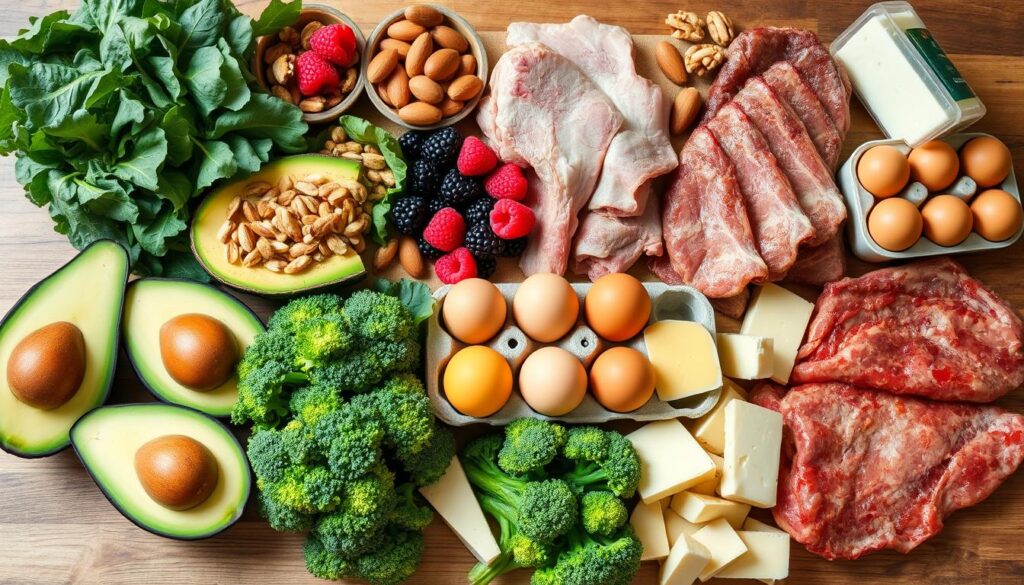
Foods to Embrace
- Avocados
- Eggs
- Leafy Greens
- Meat and Fatty Fish
- Nuts and Seeds
Foods to Avoid
- Breads and Pastas
- Sugary Snacks
- Starchy Vegetables
- High-Carb Fruits
- Processed Foods
Building Your Keto Shopping List
It’s key to make a detailed shopping list for a ketogenic lifestyle. Stick to whole, unprocessed foods to keep on track.
| Category | Examples |
|---|---|
| Proteins | Chicken, Beef, Salmon |
| Fats | Olive Oil, Butter, Coconut Oil |
| Vegetables | Spinach, Kale, Broccoli |
| Snacks | Almonds, Cheese, Pork Rinds |
| Beverages | Water, Tea, Coffee |
Health Benefits of Going Keto
Starting a keto diet can greatly improve your health. One big advantage is losing weight. This happens because your body uses fat for energy instead of carbs.
- Blood Sugar Control: A low-carb diet helps keep blood sugar stable, which is good for type 2 diabetes patients.
- Mental Clarity: Many find their focus and thinking clearer on a ketogenic diet.
- Increased Energy Levels: You get more consistent energy all day, without the ups and downs from carbs.

New studies suggest keto diets might help with brain health too. They’re looking into how it affects epilepsy and other brain issues. The early results are encouraging and could open up more benefits for those on a low-carb diet.
| Health Benefit | Description |
|---|---|
| Weight Loss | Helps burn fat by cutting down on carbs. |
| Blood Sugar Control | Keeps blood sugar steady, helping with diabetes. |
| Mental Clarity | Improves thinking and focus by changing how the brain works. |
| Energy Levels | Gives steady energy, avoiding the highs and lows from carbs. |
| Neurological Health | May help with conditions like epilepsy and Alzheimer’s. |
Common Challenges and How to Overcome Them
Starting a ketogenic lifestyle is exciting, but it comes with challenges. Knowing these challenges helps you successfully start keto and keep it up.
The Keto Flu Explained
Many beginners face the keto flu, a set of symptoms as your body gets used to ketosis. Symptoms include headaches, fatigue, and irritability. To ease these, drink plenty of water, eat more electrolytes like sodium, potassium, and magnesium, and get enough sleep.
Managing Social Situations
It’s hard to stick to keto in social situations. Plan by looking up restaurant menus for keto options, bring your own snacks, and tell friends and family about your diet. This way, they can support you.
Tracking Your Progress
It’s important to track your journey for long-term success. Here are some ways to do it:
- Weight Measurements: Regularly weigh yourself to monitor changes.
- Body Composition: Use tools like calipers or scales to measure body fat.
- Ketone Testing: Test ketone levels using blood, urine, or breath tests.

| Method | Description |
|---|---|
| Weight Measurements | Regularly weigh yourself to monitor changes. |
| Body Composition | Use tools like calipers or scales to measure body fat. |
| Ketone Testing | Test ketone levels using blood, urine, or breath tests. |
Meal Planning on the Keto Diet
Starting a keto diet can seem daunting, but meal planning makes it easier. Organizing my meals helps me stick to the low-carb diet basics needed for ketosis.
Here are some practical tips to kickstart your ketogenic journey:
- Balance Your Macronutrients: Make sure each meal has healthy fats, enough protein, and few carbs.
- Plan Ahead: Cook your meals early to avoid high-carb temptations.
- Incorporate Variety: Try different recipes to keep your diet interesting and balanced.
Sample Meal Plan for a Day:
- Breakfast: Scrambled eggs with spinach and avocado.
- Lunch: Grilled chicken salad with olive oil dressing.
- Dinner: Baked salmon with asparagus and cauliflower rice.
- Snacks: Nuts, cheese, or a low-carb smoothie.
Meal prepping helps me stay on track. By setting aside time each week, I follow the low-carb diet basics. This way, I have tasty, keto-friendly meals ready to go.

Exercise and Physical Activity on Keto
Staying active while on a ketogenic diet can boost your weight loss and health. Many are curious about starting keto without giving up exercise. The good news is, you can do both well.
Best Workouts for Keto Dieters
Choosing the right exercise is key for keto dieters. Low-intensity cardio like walking, swimming, or cycling works well with ketosis. Strength training is also great for keeping muscle mass and a healthy metabolism.
For variety, try resistance training and yoga. They offer physical and mental benefits.
Timing Your Meals Around Exercise
When you eat can affect your workout and recovery. Eat a meal with healthy fats and some protein 1-2 hours before working out. This gives you energy without breaking ketosis.
After working out, eat to help your muscles recover and regain energy. A good post-workout meal might include avocado, nuts, and lean proteins. This keeps you in ketosis.
| Workout Type | Benefits |
|---|---|
| Low-Intensity Cardio | Enhances fat burning and supports endurance |
| Strength Training | Builds muscle mass and boosts metabolism |
| HIIT | Improves cardiovascular health and increases calorie burn |
| Yoga | Promotes flexibility and reduces stress |
Measuring and Tracking Ketosis
Understanding what is keto means knowing how to check if you’re in ketosis. This helps you stay on track and get the health benefits you want.
There are several ways to keep an eye on your ketosis levels:
Using Ketone Meters
Ketone meters show how many ketones are in your body. Here’s a quick look at the main types:
- Blood Ketone Meters: They give exact numbers by checking beta-hydroxybutyrate levels. You need to prick your finger to get a blood sample.
- Breath Ketone Meters: They find acetone in your breath. These are easy to use and don’t hurt, but might not be as accurate.
- Urine Ketone Strips: They spot acetoacetate in your pee. They’re cheap and simple to use, but might not be as reliable over time.
| Type | Accuracy | Cost | Ease of Use |
|---|---|---|---|
| Blood | High | Moderate | Requires finger prick |
| Breath | Moderate | High | Easy and non-invasive |
| Urine | Low | Low | Simple to use |
Reading Your Body’s Signals
Aside from meters, you can learn about ketosis explained by listening to your body:
- Increased Energy Levels: Many feel more energetic once they’re in ketosis.
- Reduced Appetite: Ketosis can make you feel less hungry, helping you eat fewer calories.
- Mental Clarity: You might notice better focus and mental clarity when in ketosis.
By watching your body’s signs and using ketone meters, you can track your progress well and keep ketosis.
Conclusion: Your Journey to Keto Success
Starting the keto diet for beginners can seem daunting. But, embracing a ketogenic lifestyle opens the door to numerous health benefits. I’ve experienced firsthand the boost in energy and clarity that comes from maintaining ketosis.
While challenges like adjusting to low-carb meals may arise, understanding the science behind ketosis makes it easier to stay committed. Remember to plan your meals and stay hydrated to support your body through the transition.
Practical tips such as preparing snacks in advance and seeking support from the keto community can enhance your journey. Tracking your progress helps you stay motivated and see the positive changes unfold.
Embarking on this path requires dedication, but the rewards of improved wellness and sustained energy make it a worthwhile endeavor. I’m confident that with the right approach, you can achieve success on your ketogenic journey.
